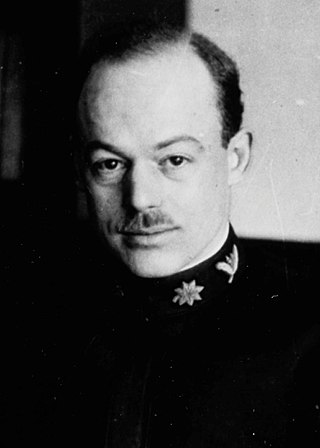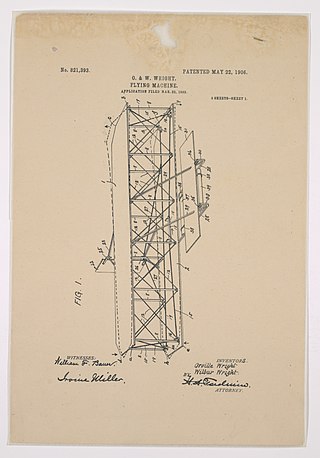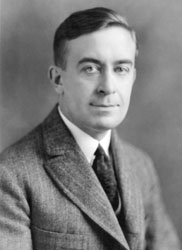Related Research Articles

The Wright brothers, Orville Wright and Wilbur Wright, were American aviation pioneers generally credited with inventing, building, and flying the world's first successful airplane. They made the first controlled, sustained flight of an engine-powered, heavier-than-air aircraft with the Wright Flyer on December 17, 1903, four miles (6 km) south of Kitty Hawk, North Carolina, at what is now known as Kill Devil Hills. In 1904 the Wright brothers developed the Wright Flyer II, which made longer-duration flights including the first circle, followed in 1905 by the first truly practical fixed-wing aircraft, the Wright Flyer III.

An aileron is a hinged flight control surface usually forming part of the trailing edge of each wing of a fixed-wing aircraft. Ailerons are used in pairs to control the aircraft in roll, which normally results in a change in flight path due to the tilting of the lift vector. Movement around this axis is called 'rolling' or 'banking'.
The Curtiss-Wright Corporation is a manufacturer and services provider headquartered in Davidson, North Carolina, with factories and operations in and outside the United States. Created in 1929 from the consolidation of Curtiss, Wright, and various supplier companies, the company was immediately the country's largest aviation firm and built more than 142,000 aircraft engines for the U.S. military during World War II.

Glenn Hammond Curtiss was an American aviation and motorcycling pioneer, and a founder of the U.S. aircraft industry. He began his career as a bicycle racer and builder before moving on to motorcycles. As early as 1904, he began to manufacture engines for airships. In 1908, Curtiss joined the Aerial Experiment Association, a pioneering research group, founded by Alexander Graham Bell at Beinn Bhreagh, Nova Scotia, to build flying machines.

Curtiss Aeroplane and Motor Company was an American aircraft manufacturer originally founded by Glenn Hammond Curtiss and Augustus Moore Herring in Hammondsport, New York. After significant commercial success in its first decades, it merged with the Wright Aeronautical to form Curtiss-Wright Corporation.

Wright Aeronautical (1919–1929) was an American aircraft manufacturer headquartered in Paterson, New Jersey. It was the successor corporation to Wright-Martin. It built aircraft and was a supplier of aircraft engines to other builders in the golden age of aviation. Wright engines were used by Amelia Earhart and Charles Lindbergh. In 1929, the company merged with Curtiss Aeroplane and Motor Corporation to form Curtiss-Wright.

Wright-Martin Aircraft Corporation was a short-lived aircraft manufacturing business venture between the Wright Company and Glenn L. Martin.

Glenn Luther Martin was an early American aviation pioneer. He designed and built his own aircraft and was an active pilot, as well as an aviation record-holder. He founded an aircraft company in 1912 which through several mergers amalgamated into what is today known as Lockheed Martin.
In patent law, a patent pool is a consortium of at least two companies agreeing to cross-license patents relating to a particular technology. The creation of a patent pool can save patentees and licensees time and money, and, in case of blocking patents, it may also be the only reasonable method for making the invention available to the public. Competition law issues are usually important when a large consortium is formed.

Jerome Clarke Hunsaker was an American naval officer and aeronautical engineer, born in Creston, Iowa, and educated at the U.S. Naval Academy and the Massachusetts Institute of Technology. His work with Gustav Eiffel outside Paris led to the first wind tunnel in the US at MIT. He was instrumental in developing a weather reporting and airway navigation. Hunsaker was also pivotal in establishing the theoretical and scientific study of aerodynamics in the United States. And he was primarily responsible for the design and construction of the Navy-Curtiss airplane (NC-4) that accomplished the first transatlantic flight, and the first successful shipboard fighter. Later he championed lighter-than-air flight but the loss of the Navy airship he designed, the USS Akron, led to the withdrawal of federal support. His WW2 chairmanship of the National Advisory Committee for Aeronautics (NACA) was notable for favouring the development of existing aircraft designs rather than experimenting with turbojets or missile technology.

The Aeronautical Division, Signal Corps (1907–1914) was the first heavier-than-air military aviation organization in history and the progenitor of the United States Air Force. A component of the U.S. Army Signal Corps, the Aeronautical Division procured the first powered military aircraft in 1909, created schools to train its aviators, and initiated a rating system for pilot qualifications. It organized and deployed the first permanent American aviation unit, the 1st Aero Squadron, in 1913. The Aeronautical Division trained 51 officers and 2 enlisted men as pilots, and incurred 13 fatalities in air crashes. During this period, the Aeronautical Division had 29 factory-built aircraft in its inventory, built a 30th from spare parts, and leased a civilian airplane for a short period in 1911.

The Burgess Company was a U.S. airplane manufacturer between 1910 and 1918.

The Curtiss Model N was a military trainer used primarily by the United States Navy during World War I.
Harry Aubrey Toulmin Sr. was the American lawyer located in Springfield, Ohio, who wrote the "flying machine" patent application that resulted in the patent granted to Dayton inventors Wilbur and Orville Wright on May 22, 1906.

Olive Ann Beech was an American aerospace businesswoman who was the co-founder, president, and chairwoman of the Beech Aircraft Corporation. She founded the company in 1932 with her husband, Walter Beech, and a team of three others. She earned more awards, honorary appointments, and special citations than any other woman in aviation history and was often referred to as the “First Lady of Aviation”.

Edson Fessenden Gallaudet was a pioneer in the field of aviation. He was best known for his development of practical airfoils and aircraft propulsion systems for use in early seaplanes.

The Wright brothers patent war centers on the patent that the Wright brothers received for their method of airplane flight control. They were two Americans who are widely credited with inventing and building the world's first flyable airplane and making the first controlled, powered, and sustained heavier-than-air human flight on December 17, 1903.

Alfred Victor Verville was an American aviation pioneer and aircraft designer who contributed to civilian and military aviation. During his forty-seven years in the aviation industry, he was responsible for the design and development of nearly twenty commercial and military airplanes. Verville is known for designing flying boats, military racing airplanes, and a series of commercial cabin airplanes. His planes were awarded with the Pulitzer Speed Classic Trophy in 1920 and 1924.

The Lindbergh Boom (1927–1929) is a period of rapid interest in aviation following the awarding of the Orteig Prize to Charles Lindbergh for his 1927 non-stop solo transatlantic flight in the Spirit of St. Louis. The Lindbergh Boom occurred during the interwar period between World War I and World War II, where aviation development was fueled by commercial interests rather than wartime necessity. During this period, dozens of companies were formed to create airlines, and aircraft for a new age in aviation. Many of the fledgling companies funded by stock went under as quick as they started as the stock that capitalized them plummeted in value following the Wall Street Crash of 1929. The Great Depression dried up the market for new aircraft, causing many aircraft companies to go into bankruptcy or get consolidated by larger entities. Air racing, record attempts, and barnstorming remained popular, as aviators tried to recapture the prizes and publicity of Lindbergh's Transatlantic flight.

Frank Henry Russell was an American aviation pioneer and the first General Manager of the Wright Brothers Company at Dayton, Ohio. He went on to co-found the Burgess Company and the Manufacturers Aircraft Association. He was the Vice President and a director of Curtiss Aeroplane & Motor Company and a director of Curtiss-Wright Corporation.
References
- ↑ Michael J. Madison; Brett M. Frischmann; Katherine J. Strandburg. 2010. Constructing commons in the cultural environment. Cornell Law Review 95:4 (May 2010), 657-709. (Notably pages 660-661.)
- ↑ Carl Shapiro, Navigating the Patent Thicket: Cross Licenses, Patent Pools, and Standard Setting, in INNOVATION POLICY AND THE ECONOMY 119, 127–28, 134 (Adam B. Jaffe et al. eds., 2000). (pages 127–128.)
- ↑ See Mfrs. Aircraft Ass’n, Inc. v. United States, 77 Ct. Cl. 481, 483–87 (1933); Harry T. Dykman, Patent Licensing Within the Manufacturer’s Aircraft Association (MAA), 46 J. PAT. OFF. SOC’Y 646, 648–50 (1964); Robert P. Merges, Contracting into Liability Rules: Intellectual Property Rights and Collective Rights Organizations, 84 CAL. L. REV. 1293, 1343–46 (1996).
- ↑ "Manufacturers Aircraft Association records, 1843-1979". Archives West . Retrieved November 16, 2023.
- ↑ "ch2". history.nasa.gov. Retrieved 2020-07-17.
- ↑ "Patent thickets and the Wright Brothers". ipbiz.blogspot.com. 2006-07-01. Archived from the original on 2007-10-30. Retrieved 2009-03-07.
In 1917, as a result of a recommendation of a committee formed by the Assistant Secretary of the Navy (The Honorable Franklin D. Roosevelt), an aircraft patent pool was privately formed encompassing almost all aircraft manufacturers in the United States. The creation of the Manufacturer's Aircraft Association was crucial to the U.S. government because the two major patent holders, the Wright Company and the Curtiss Company, had effectively blocked the building of any new airplanes, which were desperately needed as the United States was entering World War I.
- ↑ "The Wright Brothers, Patents, and Technological Innovation". buckeyeinstitute.org. Retrieved 2009-03-07.
This unusual arrangement could have been interpreted as a violation of antitrust law . . . It served a clear economic purpose: preventing the holder of a single patent on a critical component from holding up creation of an entire aircraft. . . Speed, safety, and reliability of US made airplanes improved steadily over the years the pool existed (up to 1975). Over that time several firms held large shares of the commercial aircraft market: Douglas, Boeing, Lockheed, Convair, and Martin, but no one of them dominated it for very long.
- ↑ "THE CROSS-LICENSING AGREEMENT". history.nasa.gov. Retrieved 2009-03-07.
- 1 2 "Transportation Collections," American Heritage Center, Univ. of Wyoming., retrieved 2016-07-09
- 1 2 Inventory of the Manufacturers Aircraft Association records, 1843-1979,", Rocky Mountain Online Archive (RMOA), University of New Mexico, retrieved 2016-07-09